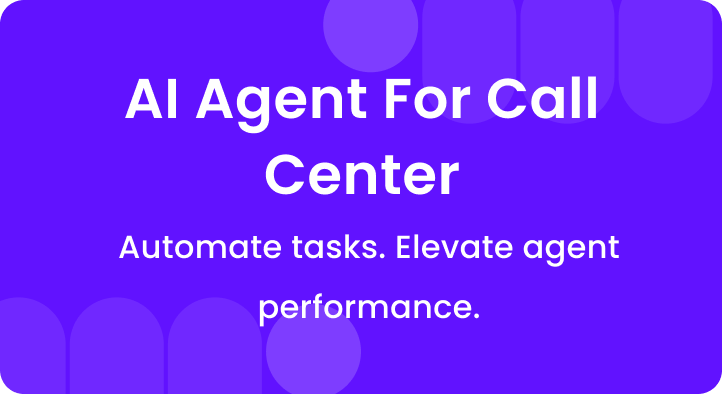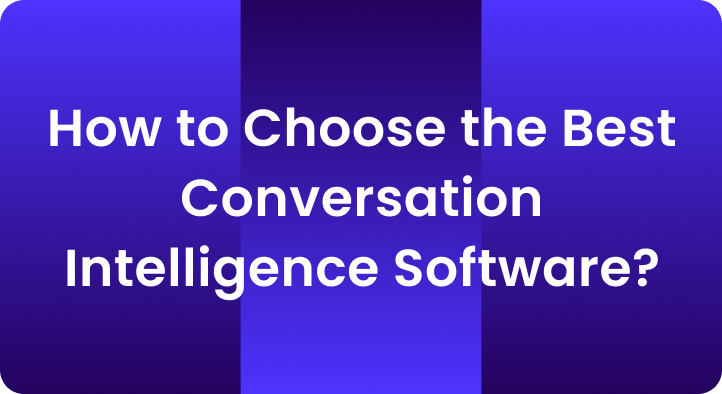Sales professionals often struggle to get quality time with the right people.
You’ve probably called many leads, only to hear them say they’re not interested or too busy.
It can be frustrating.
The truth is, most people don’t want to waste time on a sales meeting that doesn’t help them.
If you’re a small business owner or a sales manager, you’ve likely felt the pain of trying to book solid appointments.
But here’s the good news.
There’s a way to cut through the noise and reach those golden leads who actually want to listen.
That’s what the sales appointment setting is all about.
In this post, you’ll learn the basics of booking sales meetings, why it matters, and how to do it right.
We’ll talk about the struggles you might face, the best ways to handle them, and the payoff that comes when you nail your approach.
A. What is the sales appointment setting and why is it important?
Sales appointment setting is the process of reaching out to potential customers and arranging a time to talk.
It might be a phone call, video chat, or face-to-face meeting.
The main goal is simple: get their attention and spark enough interest that they agree to spend time with you.
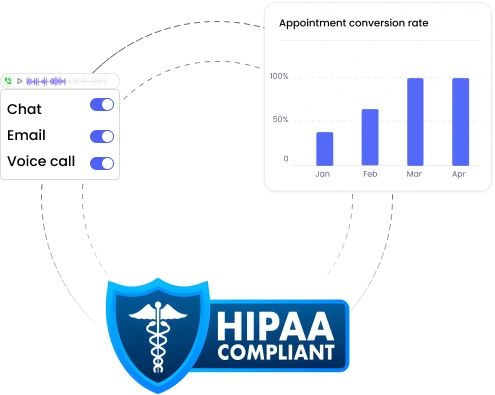
Why is it important?
Because a meaningful sales meeting opens the door to trust and clear communication.
Instead of chasing leads who don’t care, you get to talk with people who want a solution.
According to one survey, about 40% of salespeople say prospecting is one of the toughest parts of their job.
If you’re that sales rep who’s juggling 50 calls a day, you know the struggle.
When you master sales appointment setting, you also increase your chances of closing deals.
You’re not just booking a slot in someone’s busy calendar. You’re setting up a focused conversation that can lead to real results.
This is where lead qualification for appointments becomes a huge factor.
Good appointment setting confirms that you’re talking to someone who actually needs your product.
It also makes the conversation smooth. Your prospect feels like you’ve respected their time.
B. How does the sales appointment setting process work?
Think of it like preparing for a family dinner. You invite guests, plan the meal, and set the table.
That’s basically what you do with the sales appointment setting.
Here’s a simple breakdown:
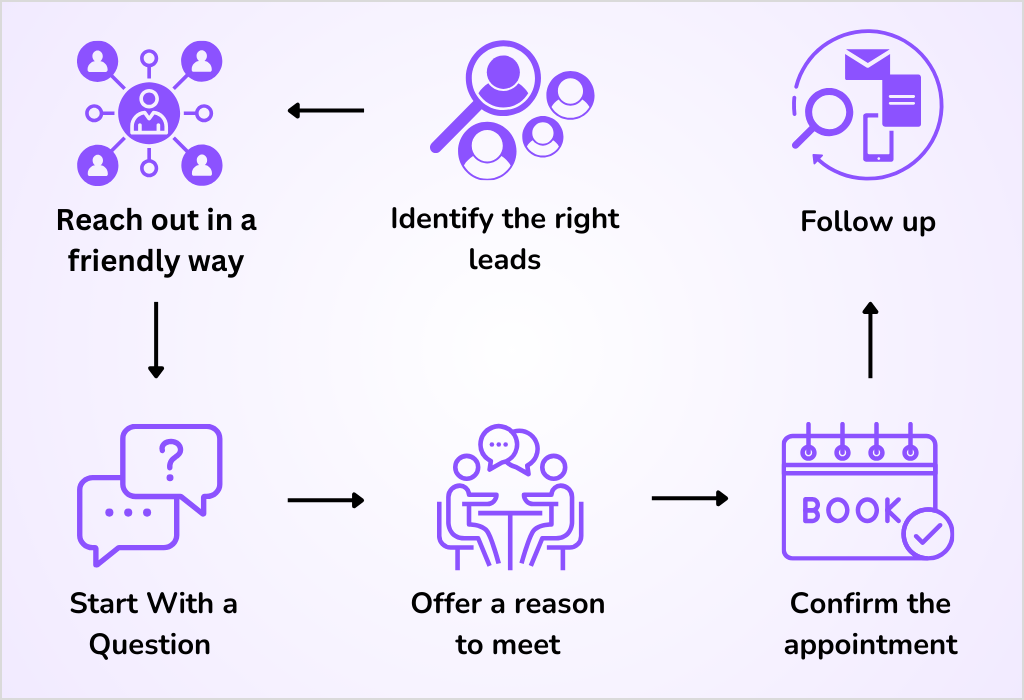
1. Identify the right leads
You don’t want to call random people.
You need to find folks who fit your ideal customer profile.
If you sell software that helps big companies manage projects, you shouldn’t focus on a small bakery that has only one staff member.
That’s like serving a giant four-course meal to a toddler.
It just won’t make sense for them.
So, you do some research to find leads that might actually benefit from your product.
2. Reach out in a friendly way
This can happen through phone calls, emails, social media messages, or even text.
Many sales reps use cold calling for appointments, but that’s not the only way.
The tone here is crucial.
You want to sound real, not like a robot.
Most people can smell a pushy script from a mile away.
3. Start with a question
Ask them about their challenges.
Show genuine interest. People appreciate that.
4. Offer a reason to meet
If they say they’re open to learning more, propose a meeting time.
Don’t drag the conversation out.
Keep it short and let them know you value their schedule.
5. Confirm the appointment
Double-check that the time and date work. Send a calendar invite.
This step helps reduce no-shows, which can be a big headache.
That’s why a clear confirmation helps.
6. Follow up
Life can be busy. Send a gentle reminder through email or a brief text.
This shows you care about being on time and organized.
It also lets your prospect know you’re serious about helping them.
C. What are the best strategies for effective appointment setting?
Here are the top five strategies from our experts that will help in setting appointments with your potential customers in no time.
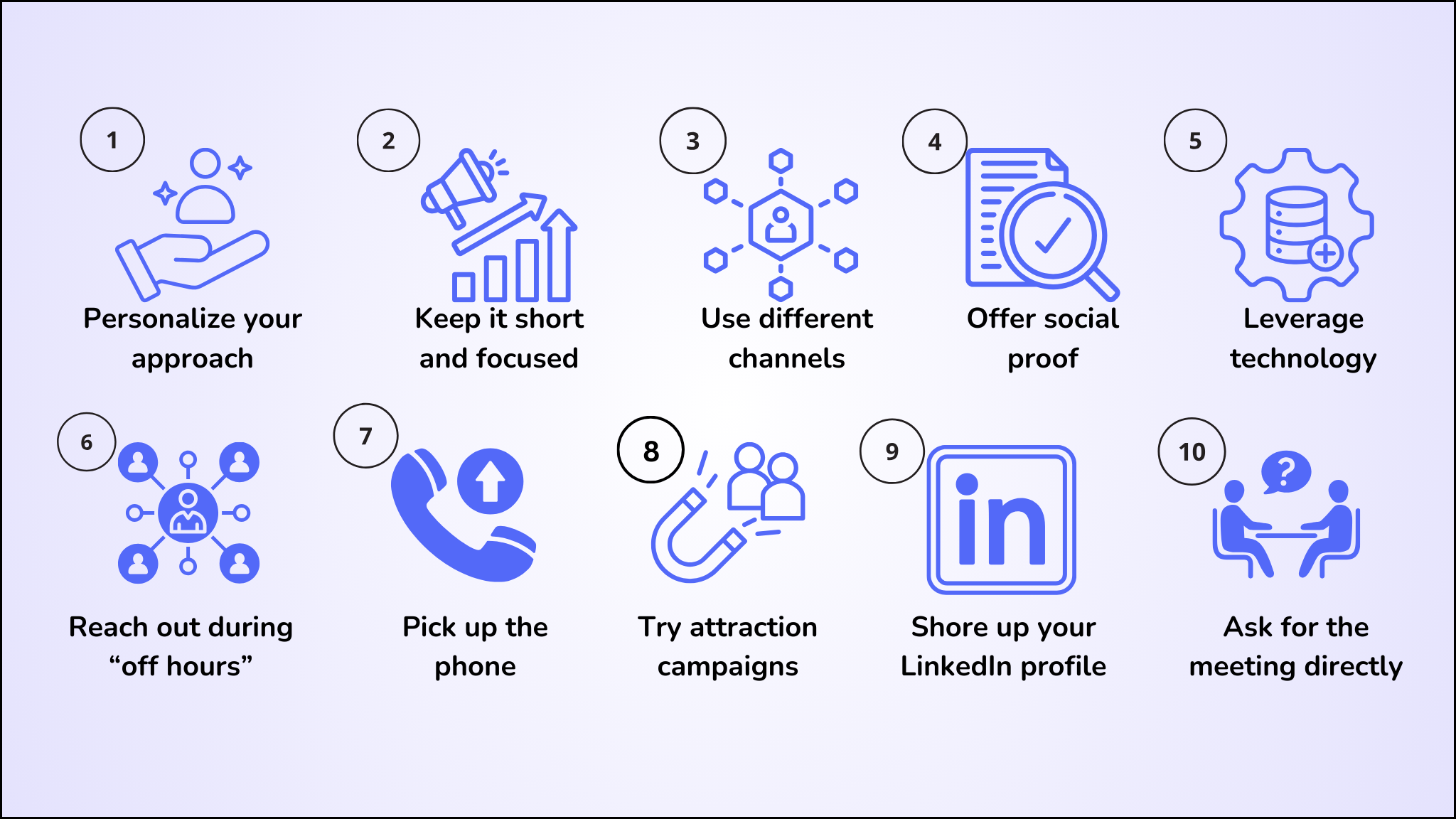
1. Personalize your approach
Imagine getting a phone call where someone says, “Hi, Ms. Garcia, I noticed your company launched a new service for small pets. How has the response been so far?”
That’s personal. It shows you did a bit of homework.
Personalization is much more powerful than a generic pitch.
2. Keep it short and focused
Don’t ramble about every single feature you offer. Stick to the main benefit that meets their needs.
Say something like, “We help companies cut down on admin tasks by 30%.”
That statement is clear and direct.
3. Use different channels
Some prospects prefer an email. Others might like a quick phone call.
Younger folks might even enjoy a social media DM.
Appointment booking strategies should meet people where they are.
Mix it up to see what works best for each lead.
4. Offer social proof
People trust recommendations from others.
If you’ve helped a company with a similar challenge, share that story.
Maybe your tool helped them boost sales conversion rates by 15%. This makes you more credible.
Just make sure that story is real or hypothetical.
That’s clear, though not pushy.
5. Leverage technology
Conversation intelligence can help you detect words or phrases that trigger positive responses.
Speech analytics software can track how often prospects show real interest.
If you notice that a certain greeting or question gets better outcomes, teach that to your entire team.
Call monitoring tools help you catch bad habits before they become a major problem.
This is how you refine your process and raise your booking rates.
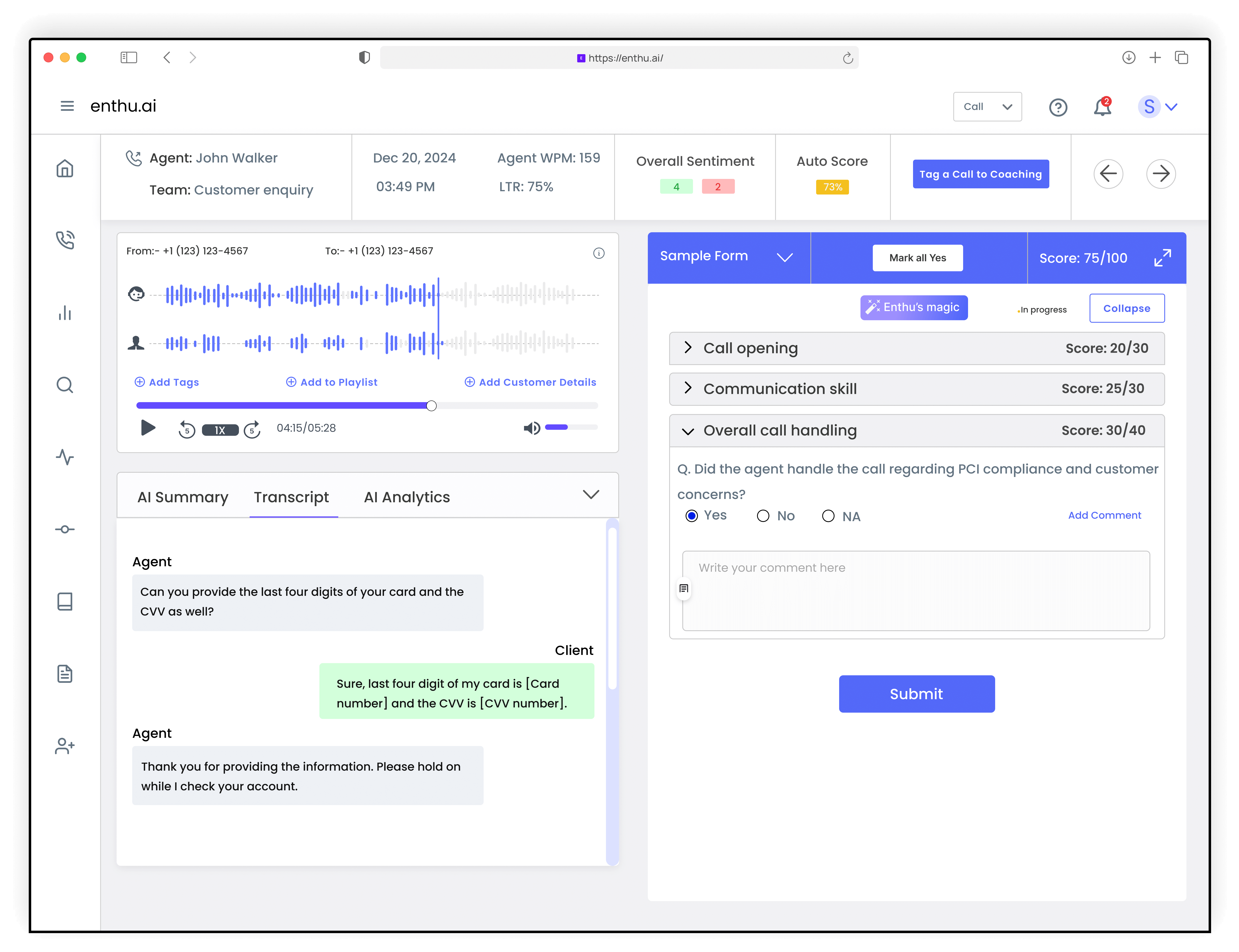
6. Reach out during “off hours”
If your prospect is a busy executive, it can be tough getting their attention during regular work hours.
Consider calling early in the morning, during lunchtime, or later in the evening.
These times often mean fewer gatekeepers and less competition from other callers.
7. Pick up the phone
With so many communication channels available, some teams shy away from calling prospects.
Yet the phone remains a powerful way to connect.
Hearing an actual voice can build trust faster than an email or a text. Don’t be afraid to dial that number.
8. Try attraction campaigns
Sometimes you need to do more than send a single email or make a couple of phone calls.
Create a mini “campaign” with multiple touches—voicemails, direct mail, emails, and social media messages.
This helps you stand out and makes it more likely your prospect will respond.
9. Shore up your LinkedIn profile
Prospects often research you online.
If your LinkedIn page is out of date or lacks details, it might turn them off.
Keep your profile polished, showcase relevant skills, and highlight any industry awards or achievements. It shows you’re professional and worth talking to.
10. Ask for the meeting directly
Don’t dance around it. Once you’ve piqued their interest, propose a time and day.
For instance: “How does Monday at 2 p.m. look?”
This nudges the prospect from “Hmm, I’ll think about it” to “Let’s pencil that in.” Being direct makes it easier for them to say yes.
D. What are the common challenges in the sales appointment setting?
Common challenges in sales appointment settings revolve around reaching the right people, overcoming objections, and effectively communicating value.
These challenges can be categorized into several key areas:
1. High rejection rates
Some leads just aren’t ready to talk. They might be busy, or they don’t see the value.
It’s important not to take it personally.
Keep track of your cold calling attempts and see which approaches work best. Then focus on that method.
2. Gatekeepers
Office assistants or automated phone systems can block you from reaching the right person.
One solution is to be polite yet persistent.
Give a brief reason for your call and ask if they can connect you.
If they say no, try another channel like LinkedIn or email.
3. Scheduling conflicts
People are swamped. They may not have time to talk for the next few weeks.
That doesn’t mean they’ll never have time.
Ask them if you can follow up next month. A genuine check-in can lead to a future appointment.
4. Maintaining motivation
Making dozens of calls a day can be draining. It’s easy to lose momentum.
When rejections pile up, you might feel like giving up.
Yet every call you make could be the one that leads to a successful sale. Creating small goals for each day can help.
For example, aim to set two appointments before lunch. This tiny win keeps you going.
5. Tracking the right metrics
Many sales teams don’t measure the right data. They might only look at the number of calls.
But they forget about the quality of those calls.
Appointment booking without qualification can be a waste of time.
That’s why you need to know your ratio of calls to appointments, plus the rate of those appointments that lead to actual deals.
E. How do you measure success in a sales appointment setting?
It’s not all about the number of appointments you book. There’s more to it.
Here are some key ways to gauge if you’re doing a good job:
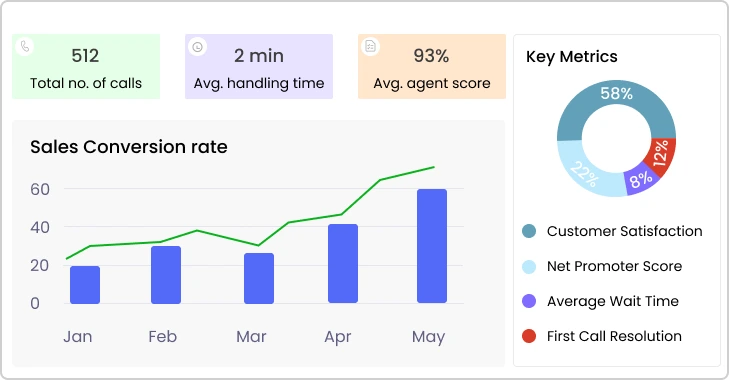
1. Appointment-to-meeting ratio
Compare how many appointments you set to how many actually happen.
If you set 20 but only 5 take place, that’s a big drop-off.
You’ll need to figure out why people aren’t showing up. Maybe you’re not sending reminders or the leads don’t feel prepared.
2. Conversion rate
Of those meetings that do happen, how many turn into a sale or a next-step action?
That percentage is crucial.
If it’s very low, you might need better lead qualification for appointments. Or your pitch might need work.
High-quality leads plus a strong pitch equals better sales conversion rates.
3. Return on investment (ROI)
How much are you spending on your appointment setting efforts?
That includes your staff’s hours, any automation tools, and training costs.
Compare that to the revenue generated by those appointments. If your ROI is low, you might want to adjust your approach.
4. Follow-up performance
Some meetings won’t turn into deals right away. That’s normal.
See how often you close those deals over time. If lots of leads go cold after the first meeting, you should reassess your follow-up.
Maybe you’re not offering enough value, or you’re taking too long to get back in touch.
5. Feedback loop
Talk to your prospects who said no. Ask why. That insight can be gold.
You might learn that your scheduling process is confusing. Or maybe your appointment booking strategies seem too generic.
Take that feedback to heart and make real improvements.
F. How can you improve your sales appointment setting process today with Enthu.AI?
Ready to turn your calls into appointment-setting machines?
Enthu.AI’s appointment setting helps.
Its AI engine analyzes every conversation, giving real-time insights on what works. That means your team can adapt instantly to keep prospects hooked.
Automated quality monitoring ensures reps follow proven strategies, while sentiment analysis reveals excitement, boredom, or uncertainty.
Plus, instant call summaries and dashboards save admin time so you can book more calls.
With Enthu.AI, you get streamlined workflows, consistent quality, and better results. More appointments, less hassle, and a truly optimized sales approach—Enthu.AI makes it possible.
For deeper insights, Enthu.AI’s advanced analytics are always completely at your fingertips.
Conclusion
Sales appointment setting might look simple on the surface. But it involves careful planning, a friendly approach, and the right use of data.
When done well, it can boost your sales pipeline. It can also reduce wasted effort on leads who aren’t the right fit.
Whether you’re a sales manager at a growing startup or a seasoned executive at a large B2B enterprise, the steps are the same.
If you’re curious about how tools like Enthu.AI can give you an edge, that option is there. But even if you don’t go high-tech right now, these fundamental tips will help you get more positive responses from your leads.
In the end, the sales appointment setting isn’t about tricking anyone. It’s about finding the right people and building a genuine bridge to them.
FAQs
1. How to set up a sales appointment?
First, research your prospect and personalize your outreach. Offer a few meeting times, confirm the date, and send a friendly reminder.
2. What is an SDR appointment setter?
An SDR appointment setter is a rep who books first meetings with prospects. They reach out, qualify leads, and schedule appointments.
3. What is an appointment setting job?
An appointment-setting job involves contacting potential clients and securing a time for a sales conversation. It’s about piquing interest, confirming details, and passing the lead to the right team.
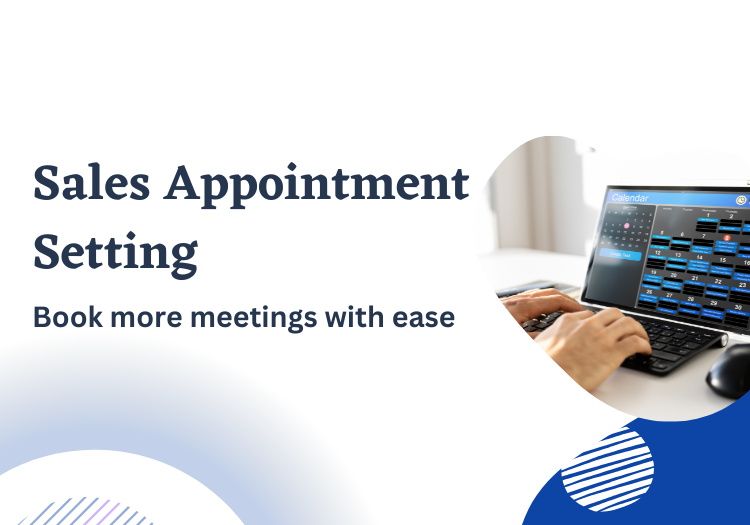


 On this page
On this page